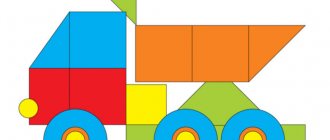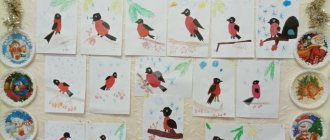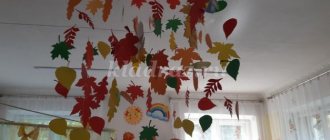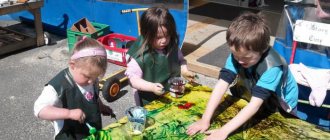Abstract of GCD on the surrounding world in the second junior group on the topic “Cookware”
Lesson on the surrounding world in kindergarten.
Second junior group. Topic: Dishes Objectives: 1. Educational:
To develop children’s knowledge about dishes and their purpose.
Teach children to name parts of dishes. Learn to name a general word. 2. Developmental:
To develop children's speech, motor skills of the hands and body, memory, and thinking.
3. Educators:
Instill in children a caring attitude towards surrounding objects.
Equipment and materials: a fragment of a video recording of the cartoon “Fedoreno Grief”, kitchen utensils, cut-out pictures (A4 format) depicting dishes, a “Fedora” costume. 1. Organizational moment. Hello guys!
You are all so beautiful today, you came to kindergarten in a good mood, and in order to maintain your mood until the end of the day, let’s do a little exercise with you. 2. Progress of the lesson:
Fedora : Do you guys recognize me? Who am I? (children's answers). One, two, three, four, (Rhythmic fist bumps and clapping alternately.) We washed the dishes: (One palm slides over the other) A teapot, a cup, a ladle, a spoon And a large ladle. (We bend our fingers one at a time for each name of the dish.) We washed the dishes, (One palm slides over the other.) We only broke the cup, the ladle also fell apart, the nose of the teapot came off, (We bend our fingers again.) We slightly broke the spoon. This is how we helped mom. (Rhythmic fist bumps and clapping alternately.) The teacher brings out the “Fedora” doll. Fedora: You know, my children suffered a great tragedy. Do you want to know which one? (Yes). Let us see what happened? The children, together with Fedora, watch a fragment of the cartoon “Fedorino's grief” (a fragment where the dishes leave the house). Fedora: Tell me guys, what happened to me? (children's answers). Fedora: That’s right, all the dishes ran away from me. Why did the dishes run away? (children's answers) Fedora : That's right, guys, because I didn't wash it. Guys, can you help me get my dishes back? (Yes). Fedora : I completely forgot which dishes ran away. Let's remember together. It lies in this magic box, I will take it out, and you will help me. I puff, puff, I don’t want to get warm anymore. The lid rang loudly: “Drink tea, the water has boiled!” Teapot
Teapot's girlfriend Has two ears, Cooks porridge and soup for Yulia.
And her name is... Saucepan
Carries water to the Master to please;
Lives with him until he falls. Cup
If I'm empty, I don't forget about myself, But when I'm carrying food, I won't pass by my mouth.
Spoon
Among spoons I am a colonel.
And my name is... Ladle
It can be deep.
It can be small. However, this is not a river. The plate
If sharpened well, it cuts everything very easily - Bread, potatoes, beets, meat, Fish, apples and butter.
Knife
Guys, tell Fedora what the pan is for?
(children's answers) What parts does the pan consist of? (children's answers) Fedora: shows the teapot. Why do we need a kettle? (children's answers) What does the teapot have? (children's answers) Fedora: Guys, why do you think we need a cup and a plate? (children's answers) Fedora : Please tell me how to use a ladle? (children's answers). Fedora : Who can tell me what a frying pan is for? (children's answers) Fedora : guys, tell me how to care for the dishes? (children's answers). Fedora: That’s right, dishes should be washed with detergents and cleaned with powder. This is a saucepan. You can cook soup in it. This is a plate. You can put food in it. This is a spoon. You can use a spoon to scoop up food and put it in your mouth. This is a cup. You can pour tea into it and drink it. This is a knife. They can be used to cut bread. This is a frying pan. You can fry cutlets on it. Fedora : Well done guys, and now you and I will turn into dishes. 3. Physical exercise (Children form a circle. The teacher is in the center of the circle, reads the text and shows the movements that the children repeat) Knock - knock - knock, knock - knock - knock. (They knock their fists against each other.) A loud knocking sound is heard. A loud chime is heard. (They stomp their feet, hands on the belt). Ding-ding - dong, ding - ding - dong. It is in the kitchen that spoons, forks, cups, and ladle are dancing. (Tilt left and right arms with a shelf in front of the chest). Tra-ta-ta, tra-ta-ta All the dishes started dancing! (Perform a “spring”, hands on the belt). Kettle lid here, there! Spoons in a cup - knock, knock! And the pots - boom - boom! Frying pans - don - don! (“Dance”, alternately putting the left and right leg forward on the heel, hands behind the back). That's how the dance is - beauty! Tra-ta-ta, tra-ta-ta! (Clap their hands.) Fedora : Thank you children for teaching me how to take care of dishes. Children, look, the dishes have returned to me. Let's see what dishes have returned. 4. Didactic game “Cut-out pictures” Children work in pairs, collecting cut-out pictures. Fedora : Tell me guys, what dishes came back to me? (children name the dishes on the cut-out pictures). Fedora : Goodbye guys, it's time for me to leave. Thank you for helping me return the dishes. Now I will take good care of her. 5. Reflection. Who came to visit us? What games did we play? Children, what did you like most about the lesson? What was difficult to accomplish? List of sources : Nishcheva N.V. Card index of outdoor games, exercises, physical education minutes, finger gymnastics.
We recommend watching:
Synopsis of GCD in the second junior group Synopsis of an open music lesson for children of the 2nd junior group Synopsis of a game lesson on search and research activities with children of the 2nd junior group Synopsis of a lesson in the 2nd junior group
Similar articles:
Summary of lessons in kindergarten in the 2nd junior group. Group room
Summary of a lesson in the junior group of kindergarten on the topic: “Human nutrition”
Lesson notes about kindergarten. Junior group
Thematic lesson on speech development on the topic: Dishes. First junior group
Thematic lesson “Dishes” on speech development for children of the first junior group
To interest the kids, she said that a hero from a fairy tale had come to visit, and from which one, they would find out by guessing
the riddle : All the dirty things got away from the grandmother, all that was left with the old lady were toads and frogs. She called for glasses and saucers - I’ll wash them if they come back. And she promised to meekly clean the pans. Since then everyone has returned, all the rubbish has disappeared from the hut. Questions: - What kind of fairy tale? (Fedorino's grief) - Who wrote it? (Korney Chukovsky) - Who came to visit us? (Fedora’s grandmother) - But what’s wrong with Fedora, why is she so anxious and sad? Let's ask Fedora what happened to her? Here I am, poor, alone. And I cry, and I cry. I would sit at the table, but the table would go out of the gate. If I could cook cabbage soup, go and look for a saucepan! And the cups and glasses were gone, only cockroaches remained. Oh oh oh! Oh oh oh! Help me bring the dishes home! — Shall we help Fedora return the dishes? Why did she run away from Fedora? - Let's follow her into the forest. What transport can you use to get to the forest? (Answers) - Here we are, let’s find the dishes (we complete the task - we name all the dishes that we saw - Fedora hurt the dishes and she doesn’t want to return home now. What should we do? Let’s call her affectionately (ball game): Fork - fork, spoon - ...., Plate - .... etc. - The dishes returned home, but they are still dirty, let's now help Fedora wash the dishes: One, two, three, four, We hit our fists against each other. We washed the dishes. Three palms against each other. A teapot, a cup, a ladle, a spoon And a large ladle. We bend our fingers one by one. We washed all the dishes And Fedora we helped. We three palms against each other. - And the saucers were delighted: “Ding, la-la- la!" And they dance and laugh: "Tink, la-la-la!" - And some dishes broke while they were washing them. We need to glue them together. We will be craftsmen. We take the dishes, name them correctly, name the color and what shape the fragment broke off... Fedora : - I won’t, I won’t, I won’t offend the dishes. I will, I will, I will love and respect the dishes! - What did we talk about today? - About the dishes? - What is it for? - Prepare food, eat. - The dishes forgive Fedorushka and treat us to sweet tea!
We recommend watching:
Summary of GCD in the 1st junior group on FEMP “Let's treat the Bunny with a carrot” Summary of GCD in the 1st junior group on the formation of a holistic picture of the world Summary of a design lesson in the 1st junior group Summary of a lesson with children of the first junior group
Similar articles:
Summary of GCD in the 1st junior group by February 23
Lesson notes for the early childhood group in kindergarten
Lesson summary for an early age group. Cockerel
Lesson summary for an early age group. Dandelion
Summary of a game development lesson in kindergarten in the second group of early age on the topic: Toys
“Choose dishes for the doll” - children's educational game
In this game, a child aged 3-4 years develops skills in using utensils and strengthens knowledge about their various types and types. Attention and speech develop - which is of particular importance in preschool age.
Type: Games with objects
Didactic task: To consolidate children’s knowledge about different types of dishes; develop the ability to use utensils for their intended purpose; cultivate resourcefulness, attention, speech.
Game rule: At the teacher’s signal, quickly select the necessary utensils (tea, dining, kitchen).
Game action: Search for utensils needed for the work of a nanny or cook.
Progress of the game: The game is played after the children have become acquainted with the work of a nanny, a cook, and have learned what kind of utensils are used in their work.
The teacher prepares three dolls for the game: one in a chef's jacket (cook), another in a robe (nanny) and the third doll is just a girl. The cook is standing at the stove (toy), the nanny is preparing the dishes for dinner, and a girl doll is sitting at the table (made of toy furniture). The teacher looks at the dolls with the children, talks about who they are, what they do, what kind of utensils they need; asks them to remember what they saw during the excursion to the kitchen. There are different dishes on the table near the teacher.
Showing an object, the teacher tells what this object is called (saucepan), who needs it (the cook). Then, turning to the child, he says:
- Kolya, please take the pan to the cook and put it on the stove. (The child completes the task.) Next, the teacher shows the bread bin; - What is this item called and who needs it? - This is a bread box. It must be taken to the nanny. - And what's that? - says the teacher, showing a teaspoon. - This is a teaspoon, it is needed to eat compote and drink tea.
So, one by one, children practice selecting dishes and correlating them with the profession of people they know. To maintain the children’s interest in the game throughout its entire duration, the teacher shows objects and talks about them in such a way as to evoke an active reaction in the children:
— And probably no one needs these dishes? (Shows a ladle, colander or teapot.) - Need it! Needed! - the children answer in unison. - Who needs a ladle? - To the cook. - Does the nanny need it too? - Needed, needed! - So, how many ladles are needed? - Two. - Let's look for another ladle.
Among the remaining dishes, the children look for a ladle and find it; they take the ladle to both the cook and the nanny.
The game “Pick up the dishes” not only helps to master knowledge about household items and their purpose, but also arouses interest in children 3-4 years old in playing with dishes: kids play the role of a nanny, a cook. They have a desire to give the doll tea, etc.






